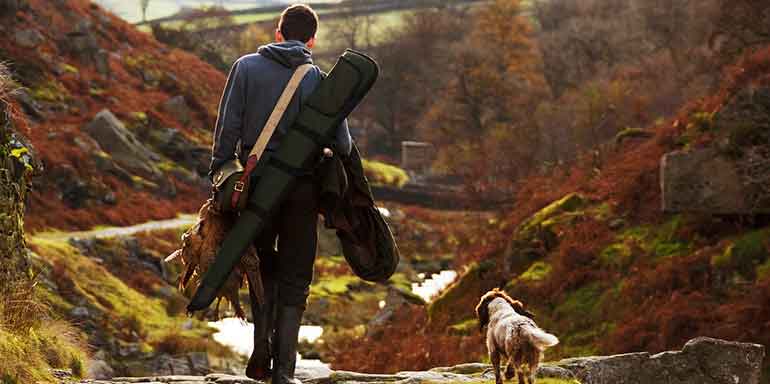There are some inherent dangers associated with hunting. That’s part of the game and as a hunter, we assume the risk all the time. But that does not mean we have to be reckless and careless. If we know the statistics of hunting injury, it will help us to take precautions seriously.
That’s the whole point of this article. And it won’t be a long one 🙂

A lot of hunters inflict themselves each year in the U.S. & Canada. I am not exaggerating at all about such hunting related morbidity and mortality. It’s the thoroughly examined output of research done by the International Hunter Education Association& other bodies.
So, you definitely go out hunting with all of your safety gears like shooting glass, electronic ear protection for shooting, and so on. Still, how these hunting injuries happen?
Hunters mostly inflict injuries themselves because of the fall, trip, and other sorts of accidents. You may find several studies that say the chance of death from an accidental injury is less than death from the drowning. Don’t believe such crap.
Some people got the serious motivation to undermine the injuries from hunting. I want to give you a clear picture that you can truly rely on. That being said, no one is motivating me to give you these statistics.
Did I run my own research to give you these statistics? No. But I spent a considerable amount of days reading a lot of journals, statistics from government bodies, and definitely from the independent researchers.
Hunting Injury Statistics
I must admit, due to several hunter educational programs, such incidents are happening a lot less now than it used to be. But still, some statistics are terrifying. Let’s check some of them.
- 87% of hunting injuries happen to male hunters. That’s no wonder at all, right?
- As per prominent orthopedic surgeonsRandall Loder and Neil Farren of the United States; they got around 35,970 hunting related injured patients. They revealed the data in 2014 and they collected the data in between 1993 and 2008. Ages of those hunters range from 10 to 70 years.

- The most common form of non-fatal hunting injury is a laceration. Knives play a great role in such non-fatal injuries (about 34%).
- It’s no surprise that most hunting-related injuries happen during the month of October, November, and December. Another not so surprising fact that around 91.8 percent of such injuries happened to the Caucasian.
- Most of the time, it happens during deer hunting. It’s so challenging and most popular that involves using high power rifles, so you know why the number is so high.
- Not just the deer hunting, most fatal & non-fatal injuries happen during the hunting of mountain goat, elk, bear, waterfowl, and various games.
- Not only firearms responsible for such injuries but heart attack during the hiking woods & hills & fall from the tree stands are responsible too. In fact, the later causes are more responsible as per some studies.
- The chance is 6 times greater that you will be hurting yourself during the hunting falling from the tree stands than your own firearm.
- At least 860 fatal & 6,132 non-fatal firearm hunting injuries were reported to the North American Association of Hunter Safety Coordinators (NAAHSC) in between 1983-1987 covering the 47 states & 8 Canadian provinces.
- In 1989, HEA reported 172 hunting-related fatalities and 1,521 non-fatal injuries throughout the entire U.S. In case you don’t know, The Hunter Education Association (HEA) collects data on injuries that are related to hunting that involves using guns and bow.
- Researchers have found that, in Montana, USA; the hunting injury rate is almost 14 times higher than in Sweden!
- Wisconsin Department of Natural Resources (DNR) reported that at least 5 hunting-related deaths and 88 of that kind injuries happened in 1990 out of total estimated 675,000 hunters in there. Their study did not cover other kinds of injuries like lacerations or illness.
- Kids and teens are equally vulnerable during the hunting too. In fact, in 2006, the National Hunter Incident Report Clearinghouse Data reported that at least 3 of such kids were dead and 38 of were seriously injured during the hunting. So don’t just stop taking kids to hunt, take safety precautions for them instead.
- A lot of hunting injury including death happens due to the post-hunting related activities most of which are not reported. Most hunting safety courses don’t cover such post-hunting safety precautions.
- Among all the terrains, most non-fatal hunting injuries happen during the mountainous terrains.
- With the duration of hunting days, the number of hunting injury is greatly related. The number of days you will be in hunting, the higher chances of such injuries.
Conclusion of Hunting Injury Statistics
I hope you are not frightened of reading all those numbers. My objective was not to scare you. To make you feel better, at least 17 million people participate in hunting and hunting-related activities each year. There is a more than $10-billion-dollar market just for the hunting, and it’s growing!
So, instead of being scared of the statistics; just exercise proper cautions while you go to hunting. Know all the shooting safety rules before you pick your gun.
Sources Of Data:

